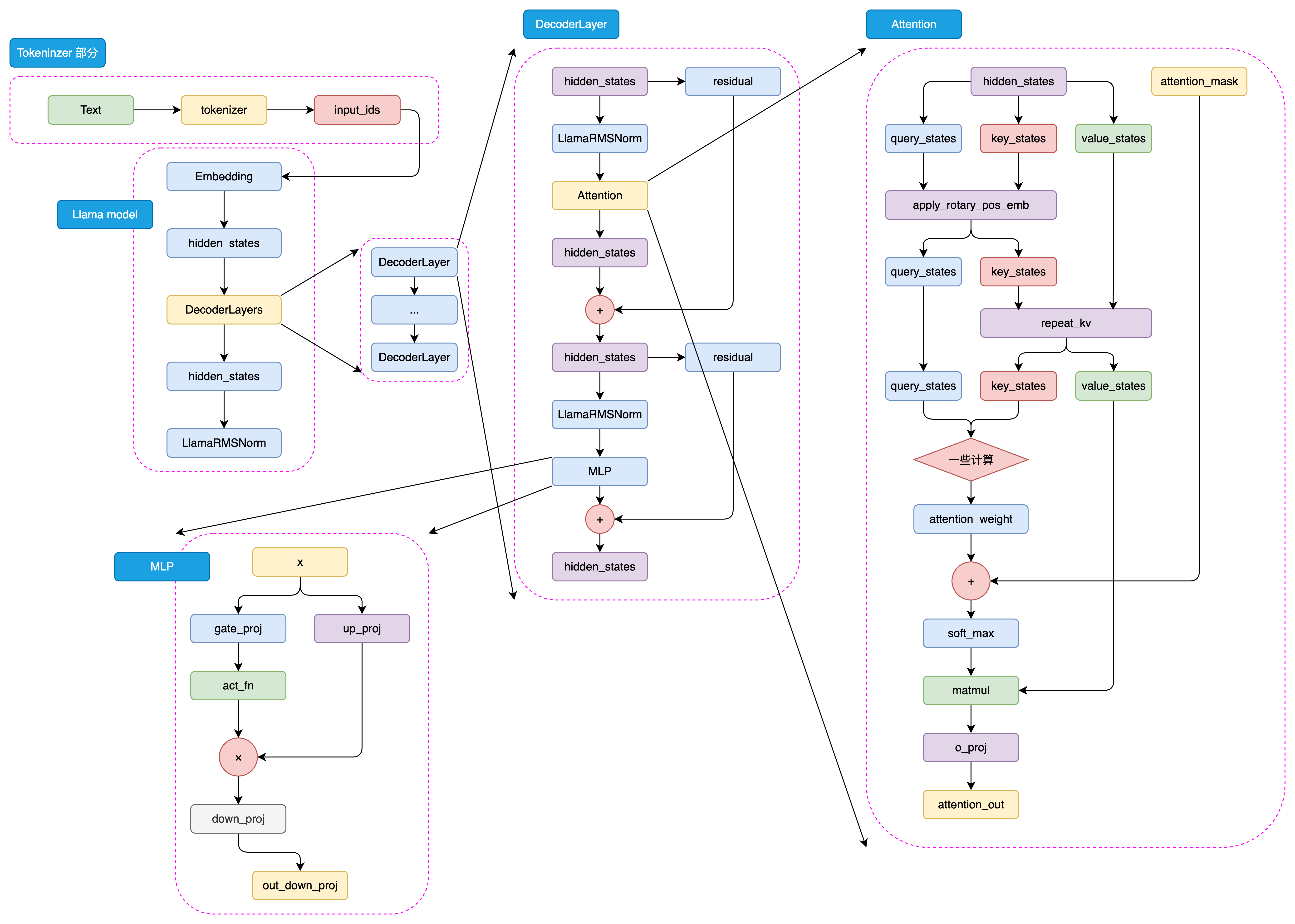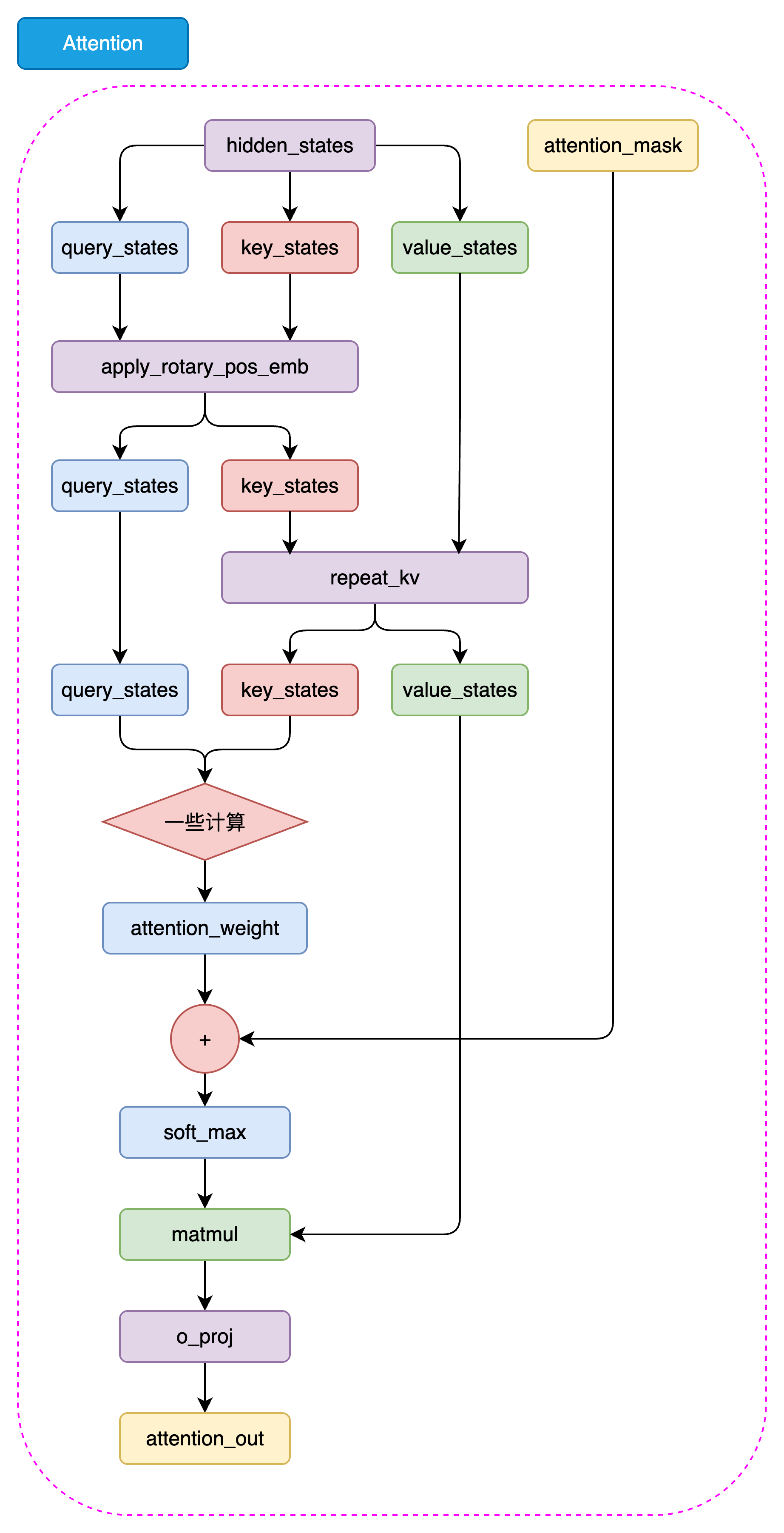大模型原理与实践:第五章-自己搭建大模型_第1部分-动手实现一个LLaMA2大模型
本文介绍了如何动手实现LLaMA2大模型,从定义超参数到构建模型核心组件。文章详细讲解了RMSNorm归一化层的数学原理和代码实现,相比传统LayerNorm更高效。同时概述了LLaMA2的整体架构,包括decoder-only的Transformer设计、GQA注意力机制等关键优化技术。通过手把手指导实现LLaMA2的各个模块,帮助读者深入理解大模型的构建细节。
第五章-自己搭建大模型_第1部分-动手实现一个LLaMA2大模型
总目录
目录
- 动手实现一个 LLaMA2 大模型
- 1.1 定义超参数
- 1.2 构建 RMSNorm
- 1.3 构建 LLaMA2 Attention
- 1.4 构建 LLaMA2 MLP模块
- 1.5 构建 LLaMA2 Decoder Layer
- 1.6 构建完整的 LLaMA2 模型
1. 动手实现一个 LLaMA2 大模型
Meta公司在2023年2月发布了LLaMA(Large Language Model Meta AI),并在7月推出了升级版LLaMA2。LLaMA2采用了decoder-only的Transformer架构,在保持高性能的同时,通过一系列优化(如RMSNorm、RoPE、GQA等)提升了训练效率和推理速度。

本章将手把手带你实现一个完整的LLaMA2模型,从最基础的归一化层到最终的文本生成,让你真正理解大模型的每一个细节。
1.1 定义超参数
在开始编写代码之前,我们需要先定义模型的超参数配置。超参数决定了模型的规模和能力上限,合理的超参数设置是训练成功的第一步。
from transformers import PretrainedConfig
class ModelConfig(PretrainedConfig):
"""
LLaMA2模型配置类
继承自PretrainedConfig以便与HuggingFace生态兼容
"""
model_type = "Tiny-K"
def __init__(
self,
dim: int = 768, # 模型隐藏层维度
n_layers: int = 12, # Transformer层数
n_heads: int = 16, # 注意力头数
n_kv_heads: int = 8, # 键值头数(用于GQA)
vocab_size: int = 6144, # 词表大小
hidden_dim: int = None, # FFN隐藏层维度
multiple_of: int = 64, # FFN维度的倍数约束
norm_eps: float = 1e-5, # 归一化层的epsilon
max_seq_len: int = 512, # 最大序列长度
dropout: float = 0.0, # Dropout概率
flash_attn: bool = True, # 是否使用Flash Attention
**kwargs,
):
self.dim = dim
self.n_layers = n_layers
self.n_heads = n_heads
self.n_kv_heads = n_kv_heads
self.vocab_size = vocab_size
self.hidden_dim = hidden_dim
self.multiple_of = multiple_of
self.norm_eps = norm_eps
self.max_seq_len = max_seq_len
self.dropout = dropout
self.flash_attn = flash_attn
super().__init__(**kwargs)
关键参数解读:
-
dim (模型维度):控制模型的表达能力,常见值有768、1024、2048等。更大的维度意味着更强的表达能力,但也需要更多显存。
-
n_layers (层数):决定模型的深度。LLaMA2-7B使用32层,我们的小模型使用12-18层。
-
n_heads (注意力头数):多头注意力机制中的头数,必须能整除dim。更多的头可以学习到更丰富的特征模式。
-
n_kv_heads (键值头数):GQA(分组查询注意力)的关键参数。当n_kv_heads < n_heads时,多个查询头共享同一组键值头,可以显著降低显存占用和提升推理速度。
-
max_seq_len (最大序列长度):模型能处理的最长文本长度。受限于显存和位置编码设计,训练时需要合理设置。
1.2 构建 RMSNorm
RMSNorm(Root Mean Square Layer Normalization)是LLaMA系列模型的重要创新之一。相比传统的LayerNorm,它省去了计算均值和减去均值的操作,在保持归一化效果的同时提升了计算效率。
数学原理:
传统LayerNorm的公式为:
LayerNorm ( x ) = x − μ σ 2 + ϵ ⋅ γ + β \text{LayerNorm}(x) = \frac{x - \mu}{\sqrt{\sigma^2 + \epsilon}} \cdot \gamma + \beta LayerNorm(x)=σ2+ϵx−μ⋅γ+β
RMSNorm简化为:
RMSNorm ( x ) = x RMS ( x ) ⋅ γ = x 1 n ∑ i = 1 n x i 2 + ϵ ⋅ γ \text{RMSNorm}(x) = \frac{x}{\text{RMS}(x)} \cdot \gamma = \frac{x}{\sqrt{\frac{1}{n}\sum_{i=1}^{n}x_i^2 + \epsilon}} \cdot \gamma RMSNorm(x)=RMS(x)x⋅γ=n1∑i=1nxi2+ϵx⋅γ
其中:
- x i x_i xi 是输入向量的第 i i i 个元素
- n n n 是向量维度
- ϵ \epsilon ϵ 是防止除零的小常数(通常为 1 0 − 5 10^{-5} 10−5 或 1 0 − 6 10^{-6} 10−6)
- γ \gamma γ 是可学习的缩放参数
代码实现:
import torch
import torch.nn as nn
class RMSNorm(nn.Module):
"""
RMS Layer Normalization
相比LayerNorm去除了均值中心化,计算更高效
"""
def __init__(self, dim: int, eps: float = 1e-5):
super().__init__()
self.eps = eps # 防止除零
self.weight = nn.Parameter(torch.ones(dim)) # 可学习的缩放因子
def _norm(self, x):
"""
计算RMS归一化
x: [batch_size, seq_len, dim]
"""
# 计算平方的均值,然后取平方根的倒数
rms = torch.rsqrt(x.pow(2).mean(-1, keepdim=True) + self.eps)
return x * rms
def forward(self, x):
"""
前向传播
保证数值稳定性:先转float32计算,再转回原类型
"""
output = self._norm(x.float()).type_as(x)
return output * self.weight
为什么RMSNorm有效?
RMSNorm的核心思想是:归一化的主要作用是控制激活值的规模,而均值中心化并非必需。通过RMS归一化,可以:
- 将激活值缩放到合理范围
- 稳定梯度传播
- 加速训练收敛
实验表明,RMSNorm在大多数任务上与LayerNorm效果相当,但计算速度提升约7-10%。
测试代码:
# 创建RMSNorm实例
args = ModelConfig()
norm = RMSNorm(args.dim, args.norm_eps)
# 生成随机输入
x = torch.randn(2, 50, args.dim) # [batch_size, seq_len, dim]
output = norm(x)
print(f"输入形状: {x.shape}")
print(f"输出形状: {output.shape}")
print(f"归一化前均值: {x.mean(-1)[0, 0]:.4f}, 标准差: {x.std(-1)[0, 0]:.4f}")
print(f"归一化后均值: {output.mean(-1)[0, 0]:.4f}, 标准差: {output.std(-1)[0, 0]:.4f}")
# 输出示例:
# 输入形状: torch.Size([2, 50, 768])
# 输出形状: torch.Size([2, 50, 768])
# 归一化前均值: -0.0234, 标准差: 1.0123
# 归一化后均值: -0.0234, 标准差: 0.9987
可以看到,RMSNorm保持了输入的形状,并有效地稳定了数值分布。
1.3 构建 LLaMA2 Attention
注意力机制是Transformer的核心。LLaMA2采用了分组查询注意力(Grouped-Query Attention, GQA),这是介于多头注意力(MHA)和多查询注意力(MQA)之间的一种折中方案。

GQA工作原理:
- MHA(Multi-Head Attention):每个查询头都有对应的键值头,参数量大但效果好
- MQA(Multi-Query Attention):所有查询头共享一组键值头,参数量小但可能损失性能
- GQA:将查询头分组,每组共享键值头,平衡了参数量和性能
假设有8个查询头和2个键值头,则4个查询头共享1个键值头。
1.3.1 repeat_kv 函数
def repeat_kv(x: torch.Tensor, n_rep: int) -> torch.Tensor:
"""
将键值头复制n_rep次以匹配查询头数量
Args:
x: [batch_size, seq_len, n_kv_heads, head_dim]
n_rep: 每个键值头需要复制的次数
Returns:
[batch_size, seq_len, n_kv_heads * n_rep, head_dim]
"""
bs, slen, n_kv_heads, head_dim = x.shape
if n_rep == 1:
return x
# 在第4个维度插入新维度并扩展
return (
x[:, :, :, None, :] # [bs, slen, n_kv_heads, 1, head_dim]
.expand(bs, slen, n_kv_heads, n_rep, head_dim)
.reshape(bs, slen, n_kv_heads * n_rep, head_dim)
)
1.3.2 旋转位置编码(RoPE)
RoPE(Rotary Position Embedding)是LLaMA的另一创新。传统位置编码将位置信息直接加到token嵌入上,而RoPE通过旋转的方式将位置信息编码到注意力机制中。
核心思想:
将query和key视为复数,通过旋转角度来编码相对位置信息。对于位置m的向量和位置n的向量,它们的内积会包含(m-n)的信息,从而实现相对位置编码。
数学推导:
对于第 m m m个位置的向量 q m q_m qm和第 n n n个位置的向量 k n k_n kn,经过RoPE后:
q m = R Θ , m ⋅ x m , k n = R Θ , n ⋅ x n q_m = R_{\Theta, m} \cdot x_m, \quad k_n = R_{\Theta, n} \cdot x_n qm=RΘ,m⋅xm,kn=RΘ,n⋅xn
其中 R Θ , m R_{\Theta, m} RΘ,m是旋转矩阵。两者的内积为:
⟨ q m , k n ⟩ = x m T R Θ , m T R Θ , n x n = x m T R Θ , n − m x n \langle q_m, k_n \rangle = x_m^T R_{\Theta, m}^T R_{\Theta, n} x_n = x_m^T R_{\Theta, n-m} x_n ⟨qm,kn⟩=xmTRΘ,mTRΘ,nxn=xmTRΘ,n−mxn
这样内积就只依赖于相对位置 ( n − m ) (n-m) (n−m),实现了相对位置编码。
步骤1:预计算频率
def precompute_freqs_cis(dim: int, end: int, theta: float = 10000.0):
"""
预计算旋转位置编码的频率
Args:
dim: 注意力头维度
end: 最大序列长度
theta: 频率基数
Returns:
freqs_cos, freqs_sin: [end, dim//2]
"""
# 计算频率:theta^(-2i/dim),i=0,1,2,...,dim/2-1
freqs = 1.0 / (theta ** (torch.arange(0, dim, 2)[:(dim // 2)].float() / dim))
# 位置索引:0, 1, 2, ..., end-1
t = torch.arange(end, device=freqs.device)
# 外积得到位置-频率矩阵
freqs = torch.outer(t, freqs).float()
# 计算cos和sin
freqs_cos = torch.cos(freqs) # [end, dim//2]
freqs_sin = torch.sin(freqs) # [end, dim//2]
return freqs_cos, freqs_sin
步骤2:调整形状用于广播
def reshape_for_broadcast(freqs_cis: torch.Tensor, x: torch.Tensor):
"""
调整频率张量形状以便广播
Args:
freqs_cis: [seq_len, head_dim]
x: [batch_size, seq_len, n_heads, head_dim]
Returns:
调整后的freqs_cis: [1, seq_len, 1, head_dim]
"""
ndim = x.ndim
assert freqs_cis.shape == (x.shape[1], x.shape[-1])
# 构造形状:除了seq_len和head_dim维度,其他设为1
shape = [d if i == 1 or i == ndim - 1 else 1 for i, d in enumerate(x.shape)]
return freqs_cis.view(shape)
步骤3:应用旋转
def apply_rotary_emb(
xq: torch.Tensor,
xk: torch.Tensor,
freqs_cos: torch.Tensor,
freqs_sin: torch.Tensor
) -> tuple[torch.Tensor, torch.Tensor]:
"""
对query和key应用旋转位置编码
Args:
xq: [batch_size, seq_len, n_heads, head_dim]
xk: [batch_size, seq_len, n_kv_heads, head_dim]
freqs_cos, freqs_sin: [seq_len, head_dim//2]
Returns:
旋转后的xq和xk
"""
# 将最后一维分成两部分,视为复数的实部和虚部
xq_r, xq_i = xq.float().reshape(xq.shape[:-1] + (-1, 2)).unbind(-1)
xk_r, xk_i = xk.float().reshape(xk.shape[:-1] + (-1, 2)).unbind(-1)
# 调整频率形状
freqs_cos = reshape_for_broadcast(freqs_cos, xq_r)
freqs_sin = reshape_for_broadcast(freqs_sin, xq_r)
# 复数乘法:(a+bi) * (c+di) = (ac-bd) + (ad+bc)i
xq_out_r = xq_r * freqs_cos - xq_i * freqs_sin
xq_out_i = xq_r * freqs_sin + xq_i * freqs_cos
xk_out_r = xk_r * freqs_cos - xk_i * freqs_sin
xk_out_i = xk_r * freqs_sin + xk_i * freqs_cos
# 合并实部和虚部
xq_out = torch.stack([xq_out_r, xq_out_i], dim=-1).flatten(3)
xk_out = torch.stack([xk_out_r, xk_out_i], dim=-1).flatten(3)
return xq_out.type_as(xq), xk_out.type_as(xk)
1.3.3 完整的Attention模块
import math
import torch.nn.functional as F
class Attention(nn.Module):
def __init__(self, args: ModelConfig):
super().__init__()
# 确定键值头数量
self.n_kv_heads = args.n_heads if args.n_kv_heads is None else args.n_kv_heads
assert args.n_heads % self.n_kv_heads == 0
# 模型并行参数(这里设为1,即不使用模型并行)
model_parallel_size = 1
self.n_local_heads = args.n_heads // model_parallel_size
self.n_local_kv_heads = self.n_kv_heads // model_parallel_size
self.n_rep = self.n_local_heads // self.n_local_kv_heads
self.head_dim = args.dim // args.n_heads
# QKV投影层
self.wq = nn.Linear(args.dim, args.n_heads * self.head_dim, bias=False)
self.wk = nn.Linear(args.dim, self.n_kv_heads * self.head_dim, bias=False)
self.wv = nn.Linear(args.dim, self.n_kv_heads * self.head_dim, bias=False)
self.wo = nn.Linear(args.n_heads * self.head_dim, args.dim, bias=False)
# Dropout
self.attn_dropout = nn.Dropout(args.dropout)
self.resid_dropout = nn.Dropout(args.dropout)
self.dropout = args.dropout
# Flash Attention支持检测
self.flash = hasattr(torch.nn.functional, 'scaled_dot_product_attention')
if not self.flash:
print("警告:使用慢速注意力实现。推荐PyTorch >= 2.0以使用Flash Attention")
# 创建因果掩码(上三角为-inf)
mask = torch.full((1, 1, args.max_seq_len, args.max_seq_len), float("-inf"))
mask = torch.triu(mask, diagonal=1)
self.register_buffer("mask", mask)
def forward(
self,
x: torch.Tensor,
freqs_cos: torch.Tensor,
freqs_sin: torch.Tensor
):
"""
前向传播
Args:
x: [batch_size, seq_len, dim]
freqs_cos, freqs_sin: 旋转位置编码频率
Returns:
[batch_size, seq_len, dim]
"""
bsz, seqlen, _ = x.shape
# 计算QKV
xq, xk, xv = self.wq(x), self.wk(x), self.wv(x)
# 重塑为多头形式
xq = xq.view(bsz, seqlen, self.n_local_heads, self.head_dim)
xk = xk.view(bsz, seqlen, self.n_local_kv_heads, self.head_dim)
xv = xv.view(bsz, seqlen, self.n_local_kv_heads, self.head_dim)
# 应用RoPE
xq, xk = apply_rotary_emb(xq, xk, freqs_cos, freqs_sin)
# 扩展K和V以匹配Q的头数
xk = repeat_kv(xk, self.n_rep)
xv = repeat_kv(xv, self.n_rep)
# 转置为 [batch, n_heads, seq_len, head_dim]
xq = xq.transpose(1, 2)
xk = xk.transpose(1, 2)
xv = xv.transpose(1, 2)
# 计算注意力
if self.flash:
# 使用Flash Attention(推荐)
output = torch.nn.functional.scaled_dot_product_attention(
xq, xk, xv,
attn_mask=None,
dropout_p=self.dropout if self.training else 0.0,
is_causal=True
)
else:
# 手动实现
scores = torch.matmul(xq, xk.transpose(2, 3)) / math.sqrt(self.head_dim)
scores = scores + self.mask[:, :, :seqlen, :seqlen]
scores = F.softmax(scores.float(), dim=-1).type_as(xq)
scores = self.attn_dropout(scores)
output = torch.matmul(scores, xv)
# 恢复形状:[batch, seq_len, n_heads, head_dim] -> [batch, seq_len, dim]
output = output.transpose(1, 2).contiguous().view(bsz, seqlen, -1)
# 输出投影
output = self.wo(output)
output = self.resid_dropout(output)
return output
注意力计算公式:
Attention ( Q , K , V ) = softmax ( Q K T d k + M ) V \text{Attention}(Q, K, V) = \text{softmax}\left(\frac{QK^T}{\sqrt{d_k}} + M\right)V Attention(Q,K,V)=softmax(dkQKT+M)V
其中:
- d k d_k dk是键的维度(head_dim)
- M M M是因果掩码,确保只能看到当前位置之前的token
1.4 构建 LLaMA2 MLP模块
MLP(多层感知机)是Transformer中的前馈网络部分。LLaMA2使用了SwiGLU激活函数,这是GLU(Gated Linear Unit)的一种变体。
SwiGLU公式:
SwiGLU ( x ) = SiLU ( W 1 x ) ⊙ ( W 3 x ) \text{SwiGLU}(x) = \text{SiLU}(W_1 x) \odot (W_3 x) SwiGLU(x)=SiLU(W1x)⊙(W3x)
其中:
- SiLU ( x ) = x ⋅ σ ( x ) = x 1 + e − x \text{SiLU}(x) = x \cdot \sigma(x) = \frac{x}{1+e^{-x}} SiLU(x)=x⋅σ(x)=1+e−xx(也称为Swish激活函数)
- ⊙ \odot ⊙表示逐元素相乘(Hadamard积)
- W 1 , W 3 W_1, W_3 W1,W3是两个独立的线性变换
代码实现:
class MLP(nn.Module):
def __init__(self, dim: int, hidden_dim: int, multiple_of: int, dropout: float):
super().__init__()
# 自动计算隐藏层维度
if hidden_dim is None:
hidden_dim = 4 * dim
hidden_dim = int(2 * hidden_dim / 3)
# 确保是multiple_of的倍数
hidden_dim = multiple_of * ((hidden_dim + multiple_of - 1) // multiple_of)
# 三个线性层
self.w1 = nn.Linear(dim, hidden_dim, bias=False) # 门控投影
self.w2 = nn.Linear(hidden_dim, dim, bias=False) # 输出投影
self.w3 = nn.Linear(dim, hidden_dim, bias=False) # 值投影
self.dropout = nn.Dropout(dropout)
def forward(self, x):
"""
前向传播:SwiGLU(x) = SiLU(W1·x) ⊙ (W3·x)
然后通过W2投影回原维度
"""
return self.dropout(self.w2(F.silu(self.w1(x)) * self.w3(x)))
为什么使用SwiGLU?
- 门控机制:通过 W 3 W_3 W3的输出控制信息流,类似LSTM的门控
- 非线性:SiLU提供平滑的非线性变换
- 实验验证:在多项NLP任务上优于传统的ReLU和GELU
隐藏层维度设计:
LLaMA采用 8 d 3 \frac{8d}{3} 38d作为隐藏层维度(其中 d d d是模型维度),这是经过大量实验优化的结果,在性能和效率间取得了良好平衡。
1.5 构建 LLaMA2 Decoder Layer
DecoderLayer是Transformer的基本构建块,它将Attention和MLP组合起来,并使用Pre-Norm结构(在子层之前应用归一化)。
Pre-Norm vs Post-Norm:
- Post-Norm(原始Transformer): x + Sublayer ( Norm ( x ) ) x + \text{Sublayer}(\text{Norm}(x)) x+Sublayer(Norm(x))
- Pre-Norm(LLaMA2): x + Sublayer ( Norm ( x ) ) x + \text{Sublayer}(\text{Norm}(x)) x+Sublayer(Norm(x))
Pre-Norm在深层网络中训练更稳定,梯度传播更顺畅。
代码实现:
class DecoderLayer(nn.Module):
def __init__(self, layer_id: int, args: ModelConfig):
super().__init__()
self.n_heads = args.n_heads
self.dim = args.dim
self.head_dim = args.dim // args.n_heads
self.layer_id = layer_id
# 注意力模块
self.attention = Attention(args)
# MLP模块
self.feed_forward = MLP(
dim=args.dim,
hidden_dim=args.hidden_dim,
multiple_of=args.multiple_of,
dropout=args.dropout,
)
# 两个归一化层
self.attention_norm = RMSNorm(args.dim, eps=args.norm_eps)
self.ffn_norm = RMSNorm(args.dim, eps=args.norm_eps)
def forward(self, x, freqs_cos, freqs_sin):
"""
前向传播:Pre-Norm + 残差连接
h = x + Attention(Norm(x))
out = h + FFN(Norm(h))
"""
# Attention子层
h = x + self.attention(self.attention_norm(x), freqs_cos, freqs_sin)
# FFN子层
out = h + self.feed_forward(self.ffn_norm(h))
return out
残差连接的重要性:
残差连接(Residual Connection)通过恒等映射使梯度能够直接传播,解决了深层网络的梯度消失问题。数学上:
∂ L ∂ x = ∂ L ∂ out ( 1 + ∂ Sublayer ∂ x ) \frac{\partial L}{\partial x} = \frac{\partial L}{\partial \text{out}} \left(1 + \frac{\partial \text{Sublayer}}{\partial x}\right) ∂x∂L=∂out∂L(1+∂x∂Sublayer)
即使 ∂ Sublayer ∂ x ≈ 0 \frac{\partial \text{Sublayer}}{\partial x} \approx 0 ∂x∂Sublayer≈0,梯度仍能通过"+1"项传播。
1.6 构建完整的 LLaMA2 模型
现在我们将所有组件整合,构建完整的Transformer模型。
from transformers.modeling_outputs import CausalLMOutputWithPast
from typing import Optional
class Transformer(PreTrainedModel):
config_class = ModelConfig
def __init__(self, args: ModelConfig = None):
super().__init__(args)
self.args = args
self.vocab_size = args.vocab_size
self.n_layers = args.n_layers
# Token嵌入层
self.tok_embeddings = nn.Embedding(args.vocab_size, args.dim)
self.dropout = nn.Dropout(args.dropout)
# 堆叠Decoder层
self.layers = torch.nn.ModuleList([
DecoderLayer(layer_id, args) for layer_id in range(args.n_layers)
])
# 最终归一化和输出层
self.norm = RMSNorm(args.dim, eps=args.norm_eps)
self.output = nn.Linear(args.dim, args.vocab_size, bias=False)
# 权重共享:嵌入层和输出层共享权重
self.tok_embeddings.weight = self.output.weight
# 预计算RoPE频率
freqs_cos, freqs_sin = precompute_freqs_cis(
self.args.dim // self.args.n_heads,
self.args.max_seq_len
)
self.register_buffer("freqs_cos", freqs_cos, persistent=False)
self.register_buffer("freqs_sin", freqs_sin, persistent=False)
# 初始化权重
self.apply(self._init_weights)
# 特殊层使用缩放初始化
for pn, p in self.named_parameters():
if pn.endswith('w3.weight') or pn.endswith('wo.weight'):
torch.nn.init.normal_(p, mean=0.0, std=0.02/math.sqrt(2 * args.n_layers))
self.last_loss = None
self.OUT = CausalLMOutputWithPast()
def _init_weights(self, module):
"""权重初始化"""
if isinstance(module, nn.Linear):
torch.nn.init.normal_(module.weight, mean=0.0, std=0.02)
if module.bias is not None:
torch.nn.init.zeros_(module.bias)
elif isinstance(module, nn.Embedding):
torch.nn.init.normal_(module.weight, mean=0.0, std=0.02)
def forward(
self,
tokens: torch.Tensor,
targets: Optional[torch.Tensor] = None,
**kwargs
):
"""
前向传播
Args:
tokens: [batch_size, seq_len]
targets: [batch_size, seq_len](训练时)
Returns:
包含logits和loss的输出对象
"""
# 兼容性处理
if 'input_ids' in kwargs:
tokens = kwargs['input_ids']
if 'attention_mask' in kwargs:
targets = kwargs['attention_mask']
_bsz, seqlen = tokens.shape
# Token嵌入
h = self.tok_embeddings(tokens)
h = self.dropout(h)
# 获取当前序列长度的RoPE频率
freqs_cos = self.freqs_cos[:seqlen]
freqs_sin = self.freqs_sin[:seqlen]
# 逐层前向传播
for layer in self.layers:
h = layer(h, freqs_cos, freqs_sin)
# 最终归一化
h = self.norm(h)
if targets is not None:
# 训练模式:计算完整logits和loss
logits = self.output(h)
self.last_loss = F.cross_entropy(
logits.view(-1, logits.size(-1)),
targets.view(-1),
ignore_index=0, # 忽略padding
reduction='none'
)
else:
# 推理模式:只计算最后一个位置
logits = self.output(h[:, [-1], :])
self.last_loss = None
self.OUT.__setitem__('logits', logits)
self.OUT.__setitem__('last_loss', self.last_loss)
return self.OUT
@torch.inference_mode()
def generate(
self,
idx,
stop_id=None,
max_new_tokens=256,
temperature=1.0,
top_k=None
):
"""
自回归生成
Args:
idx: 初始token序列 [batch_size, seq_len]
stop_id: 停止token ID
max_new_tokens: 最多生成的token数
temperature: 采样温度(0为贪婪解码)
top_k: Top-K采样
Returns:
生成的token序列
"""
index = idx.shape[1]
for _ in range(max_new_tokens):
# 截断过长序列
idx_cond = idx if idx.size(1) <= self.args.max_seq_len else idx[:, -self.args.max_seq_len:]
# 前向传播
logits = self(idx_cond).logits
logits = logits[:, -1, :]
if temperature == 0.0:
# 贪婪解码
_, idx_next = torch.topk(logits, k=1, dim=-1)
else:
# 温度采样
logits = logits / temperature
# Top-K采样
if top_k is not None:
v, _ = torch.topk(logits, min(top_k, logits.size(-1)))
logits[logits < v[:, [-1]]] = -float('Inf')
probs = F.softmax(logits, dim=-1)
idx_next = torch.multinomial(probs, num_samples=1)
# 检查停止token
if idx_next == stop_id:
break
# 添加新token
idx = torch.cat((idx, idx_next), dim=1)
return idx[:, index:] # 只返回新生成的部分
模型总结:
我们构建的模型包含:
- 输入层:Token嵌入 + Dropout
- N个Decoder层:每层包含Self-Attention和FFN
- 输出层:RMSNorm + 线性投影到词表
模型参数量计算(以dim=1024, n_layers=18为例):
- Token嵌入: 6144 × 1024 = 6.3 M 6144 \times 1024 = 6.3M 6144×1024=6.3M
- 每层参数:约 12 M 12M 12M(Attention占 8 M 8M 8M,FFN占 4 M 4M 4M)
- 总参数:约 6.3 M + 18 × 12 M ≈ 220 M 6.3M + 18 \times 12M \approx 220M 6.3M+18×12M≈220M
更多推荐
 已为社区贡献69条内容
已为社区贡献69条内容









所有评论(0)